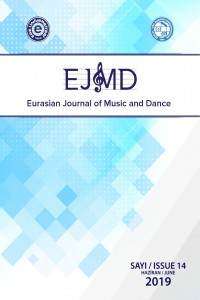KÜLTÜREL MİRAS OLARAK GELENEKSEL MÜZİK KÜLTÜRLERİNİN ANLAŞILMASI VE KORUNMASI, “TÜRK KLASİK MÜZİĞİ” VE “GELENEKSEL KORE MÜZİĞİ”
Öz
Bu makalede, geleneksel Türk sanat müziği ve geleneksel Kore müziği örnekleri üzerinden geleneksel müzik
kültürlerin korunması ve anlaşılması konusunda temel bazı noktalar üzerinde durularak, kültürel miras niteliğine
sahip bu iki kültürün ortak özellikleri, Kore ve Türk toplumları açısından bu müziklerin yeri, bu müzik
kültürlerinin genç kuşaklara tanıtılması ve anlam dünyalarının anlaşılması için bilimsel çalışmalar yapılmasının
önemi ve Türk ve Kore toplumlarının bu konuda işbirliği oluşturmalarının önemi üzerinde durulmaktadır.
Anahtar Kelimeler
Kültürel Miras Geleneksel Türk Sanat Müziği Geleneksel Kore Müziği Müzik Kültürü Kültür Erozyonu.
Kaynakça
- Aksüt Sadun. (1993). Türk Müziğinin 100 Bestekârı. İstanbul: İnkılap Kitapevi.
- Behar, C. (2003). Aşk Olmayınca Meşk Olmaz. İstanbul: Yapı Kredi Yayınları.
- Choi Yu-jun. (2019). Modernity as Postcolonial Encounter in Korean Music Decentering Musical Modernity: Perspectives on East Asian and European Music History Eds: Tobias Janz, Chien-Chang Yang C. 33. Musik und Klangkultur. transcript Verlag.
- Finkelstein, S. (1995). Besteci ve Ulus: Müzikte Halk Mirası. (çev. M. Halim Spatar). İstanbul: Pencere Yayınları.
- Breon, G. (2007). Contemprorary Korean music. [in] Music of Korea. edited by Byong Won Lee &Yong- Shik Lee. Seoul, Korea: The National Center for Korean Traditional Performing Arts,.
- Hoşses, S. (1986). Mûsıkîmiz Üzerine Düşünceler. Türk müziğinin Dünü Bugünü ve Yarını (içinde) Derleyen: Feyzi Halıcı, Konya Kültür ve Turizm Derneği Yayını.
- KCIS: Korean Culture and Information Service (South Korea) (2014). Guide to Korean Culture: Korea's cultural heritage, yayınlayan: 길잡이미디어
- Körükçü Ç. (1998). Türk Sanat Müziği. İstanbul: Hürriyet Gazetecilik ve Matbaacılık.
- Özalp M. N. (2000). İstanbul: Türk Mûsıkîsi Tarihi. Milli Eğitim Bakanlığı Yayınları.
- Robert Koehler, Jin-hyuk Lee (2015). Traditional Music: Sounds in Harmony with Nature. 8. cilt/Korea Essentials. Seoul Selection.
- T.C. Kültür ve Turizm Bakanlığı. (2017). T.C. Kültür ve Turizm Bakanlığı Araştırma ve Eğitim Genel Müdürlüğü tarafından yayınlanan 29.05.2017 tarihli genelge https://www.kutso.org.tr/wpcontent/ uploads/2017/06/52744ayin-i-serif-hakkinda-genelgepdf.pdf
- Tanrıkorur, C. (2003). “Osmanlı Dönemi Türk Mûsıkîsi”, İstanbul: Dergah Yayınları.
- Tekelioğlu, O. (2004). An Inner History of ‘Turkish Music Revolution’-Demise of a Music Magazine. (içinde) Anders Hammarlund, Tord Olsson&Elisabeth Özdalga, Sufism, Music and Society in Turkey and the Middle East, Swedish Research Institute in Istanbul. Transactions. Vol. 10, London&New York : Routledge Curzon, s.111-124.
- UNESCO. (2013). Somut Olmayan Kültürel Mirasın Korunması Sözleşmesi. Paris, 17 Ekim 2003. http://teftis.kulturturizm.gov.tr/TR-14281/somut-olmayan-kulturen-mirasin-korunmasi-sozlesmesi.html
- Ki-Beom Jang (2008). Layers of Thought on Korean Music, Music Education and the Value of Music and Arts in the Context of Education and Human Development. (in) Educating in the Arts: The Asian Experience: Twenty-Four Essays. 11. cilt/Education in the Asia-Pacific Region: Issues, Concerns and Prospects Ed. Lindy Joubert. Springer Science & Business Media.
Understanding and Preservation of Traditional Music Cultures as a Cultural Heritage: Turkish Classical Music and Traditional Korean Music
Öz
In this article, through the examples of Classical Turkish Music and Traditional Korean Music, common
features of traditional and national music cultures as a part of cultural heritage, their place in terms of Korean
and Turkish societies, the importance of the introduction of these music cultures to the young generations, the
importance of scientific studies to understand the meaning worlds of this music cultures and how the Turkish and
Korean societies can create cooperation on this issue, will be discussed.
Anahtar Kelimeler
Cultural Heritage Traditional Turkish Art Music Traditional Korean Music Music Culture Cultural Erosion.
Kaynakça
- Aksüt Sadun. (1993). Türk Müziğinin 100 Bestekârı. İstanbul: İnkılap Kitapevi.
- Behar, C. (2003). Aşk Olmayınca Meşk Olmaz. İstanbul: Yapı Kredi Yayınları.
- Choi Yu-jun. (2019). Modernity as Postcolonial Encounter in Korean Music Decentering Musical Modernity: Perspectives on East Asian and European Music History Eds: Tobias Janz, Chien-Chang Yang C. 33. Musik und Klangkultur. transcript Verlag.
- Finkelstein, S. (1995). Besteci ve Ulus: Müzikte Halk Mirası. (çev. M. Halim Spatar). İstanbul: Pencere Yayınları.
- Breon, G. (2007). Contemprorary Korean music. [in] Music of Korea. edited by Byong Won Lee &Yong- Shik Lee. Seoul, Korea: The National Center for Korean Traditional Performing Arts,.
- Hoşses, S. (1986). Mûsıkîmiz Üzerine Düşünceler. Türk müziğinin Dünü Bugünü ve Yarını (içinde) Derleyen: Feyzi Halıcı, Konya Kültür ve Turizm Derneği Yayını.
- KCIS: Korean Culture and Information Service (South Korea) (2014). Guide to Korean Culture: Korea's cultural heritage, yayınlayan: 길잡이미디어
- Körükçü Ç. (1998). Türk Sanat Müziği. İstanbul: Hürriyet Gazetecilik ve Matbaacılık.
- Özalp M. N. (2000). İstanbul: Türk Mûsıkîsi Tarihi. Milli Eğitim Bakanlığı Yayınları.
- Robert Koehler, Jin-hyuk Lee (2015). Traditional Music: Sounds in Harmony with Nature. 8. cilt/Korea Essentials. Seoul Selection.
- T.C. Kültür ve Turizm Bakanlığı. (2017). T.C. Kültür ve Turizm Bakanlığı Araştırma ve Eğitim Genel Müdürlüğü tarafından yayınlanan 29.05.2017 tarihli genelge https://www.kutso.org.tr/wpcontent/ uploads/2017/06/52744ayin-i-serif-hakkinda-genelgepdf.pdf
- Tanrıkorur, C. (2003). “Osmanlı Dönemi Türk Mûsıkîsi”, İstanbul: Dergah Yayınları.
- Tekelioğlu, O. (2004). An Inner History of ‘Turkish Music Revolution’-Demise of a Music Magazine. (içinde) Anders Hammarlund, Tord Olsson&Elisabeth Özdalga, Sufism, Music and Society in Turkey and the Middle East, Swedish Research Institute in Istanbul. Transactions. Vol. 10, London&New York : Routledge Curzon, s.111-124.
- UNESCO. (2013). Somut Olmayan Kültürel Mirasın Korunması Sözleşmesi. Paris, 17 Ekim 2003. http://teftis.kulturturizm.gov.tr/TR-14281/somut-olmayan-kulturen-mirasin-korunmasi-sozlesmesi.html
- Ki-Beom Jang (2008). Layers of Thought on Korean Music, Music Education and the Value of Music and Arts in the Context of Education and Human Development. (in) Educating in the Arts: The Asian Experience: Twenty-Four Essays. 11. cilt/Education in the Asia-Pacific Region: Issues, Concerns and Prospects Ed. Lindy Joubert. Springer Science & Business Media.
Ayrıntılar
| Birincil Dil | Türkçe |
|---|---|
| Konular | Müzik |
| Bölüm | Makaleler |
| Yazarlar | |
| Yayımlanma Tarihi | 30 Haziran 2019 |
| Gönderilme Tarihi | 30 Haziran 2019 |
| Yayımlandığı Sayı | Yıl 2019 Sayı: 14 |
Kaynak Göster
Eurasian Journal of Music and Dance


